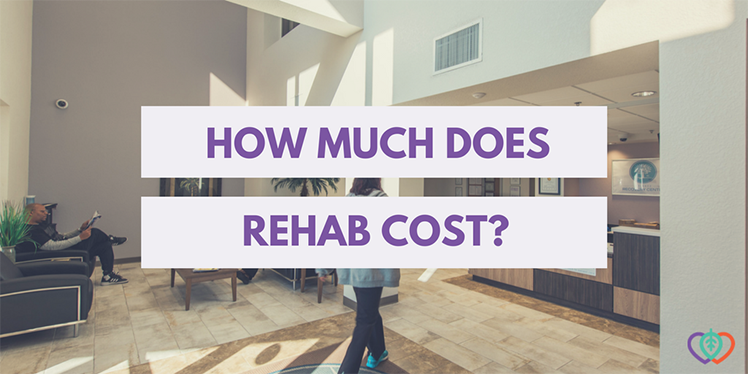Because of perceived high prices, only a small percentage of individuals with addiction pursue treatment. The cost of rehab, however, is minuscule compared to the potential health and social costs of avoiding treatment. Getting help now can help you prevent these negative consequences.
Each day, millions of Americans walk around with an addiction. According to a 2016 report by the U.S. surgeon general, nearly 21 million people in the United States have a substance use disorder. Yet only 10 percent of these individuals receive substance abuse treatment.
Why is this? Part of the reason relates to the costs. Between 2011 and 2014, almost 40 percent of Americans with a substance use disorder that required treatment didn’t go to rehab because they believed they could not afford it or they did not have health insurance.
But the cost of treatment pales in comparison to the cost of addiction. And many people do not realize that insurance can significantly reduce the price of rehab. New laws have passed that require insurance companies to cover addiction and mental health treatment.
40% of Americans
with a substance use disorder didn’t go to rehab because they believed they could not afford it.

How Much Is Rehab?
Addiction centers nationwide vary in price for each level of care. People with more severe substance use disorders likely need extended and more intensive treatment. Intensive care generally is more expensive than standard treatment.
Detox
Detox is the process of ridding drugs from the body and safely overcoming withdrawal. The estimated average cost of a 30-day detox program ranges from $250 to $800 per day based on information from drug treatment facilities across the United States.
Residential Treatment
The estimated cost of basic residential treatment, which often involves assessments and around-the-clock supervision, is between $2,000 and $20,000. Long-term residential care, lasting between 60 and 90 days, may cost twice as much.
Some luxury rehab facilities charge more than $25,000 for 30 days of treatment. But most private treatment centers charge less than that.
Outpatient Rehab
Outpatient care allows individuals to live at home while receiving treatment. Through a series of appointments, patients learn to be drug-free without living at a facility. Outpatient care often costs about $5,000 for a three-month program. Some facilities may charge up to $10,000 for outpatient treatment.
Intensive Outpatient Rehab
Intensive outpatient treatment is a more comprehensive version of outpatient care that generally includes multiple appointments per week that last about three hours per day. This level of care can cost between $3,000 and $10,000 for 30 days of treatment.
Partial Hospitalization Programs
Partial hospitalization programs, on the other hand, are intended for patients who need intense treatment during the day but can return to a stable home environment each evening. PHP generally costs between $350 and $450 per day.
Medication-Assisted Opioid Treatment
A 2016 report by the U.S. Department of Defense estimated the cost of treatment for various opioid treatment programs.
According to the report, buprenorphine-assisted treatment that includes medication and two weekly visits costs about $5,980 per year. Methadone-assisted treatment comprising daily integrated psychosocial and medical support costs $6,552 per year, and naltrexone-assisted treatment that includes drug administration and related services costs $14,112 per year.
Cost-Free Programs
While treatment centers can be quite expensive, some facilities offer payment assistance or sliding fee scales. Other locations offer programs free of charge, paid for by state taxes. These state-sponsored programs typically have long waiting lists.
Support groups such as Alcoholics Anonymous and Narcotics Anonymous are another option for people in recovery. For more than six decades, these 12-step programs have helped millions of people achieve or maintain sobriety through regular meetings. Some faith-based organizations offer free treatment options as well.
Looking for more information about the cost of rehab?We can help you.
Paying for Rehab
Insurance is the most common payment option for rehab. Every plan is different, and most require patients to pay deductibles or copayments. The Affordable Care Act requires all insurance plans to cover treatment for mental health problems, including substance use disorders. In rare cases, patients may pursue treatment without the help of insurance.
Private Insurance Covers Rehab
Health insurance plans marketed by the private health insurance industry are an alternative to government-run insurance programs. Often offered through employers, these plans cover health care for more than half of Americans.
Many people do not want to pay thousands to attend rehab, even when addiction has overtaken their lives. Fortunately, the Affordable Care Act requires companies to offer competitive insurance plans to full-time employees, and it requires states to offer comprehensive health insurance plans to individuals.
Public health insurance, such as Medicaid and Medicare, also provides health care coverage to millions of Americans who don’t have employer-based or private insurance.
But insurance doesn’t cover everything. Like other health services, patients will have to pay some costs out of pocket. However, there are a variety of ways to pay for rehab, and it’s worth it. In addition, the prices have declined collectively over the last decade.
Paying Out of Pocket
Paying for rehab completely out of pocket is rare, but some individuals choose this route to attend luxury rehab facilities or to conceal their treatment from employers. Most drug rehab facilities have rates for cash payment.
Out-of-pocket payments may be more feasible for less intensive outpatient treatment. Intensive residential treatment is much more expensive. The cost depends on the facility and the type of treatment provided. It often ranges from $5,000 to $50,000.
Individuals who pay for drug rehab out of pocket may consider raising money in a variety of ways. They can sell personal items, downsize their living situation, ask for loans from friends and family or ask for cash donations.
Financing Options
Paying out of pocket isn’t realistic for many people. If a patient is enrolling in a residential treatment program, he or she will likely be out of work for at least 30 days. That amount of missed time at work can cause bills to stack up, making copayments and deductibles difficult to afford.
The goal of drug and alcohol rehab is to set the person in recovery up for success after treatment, not to bankrupt them. Most facilities offer affordable financing options that are based on individual circumstances. Some facilities also offer monthly scholarships that help cover some of the costs of treatment.
Patients can also apply for personal loans to cover the remaining costs of treatment, or they may consider paying with a credit card. The interest accrued by loans and credit cards may seem unappealing, but it’s cheaper than the long-term costs of ignoring the need for treatment.
State-Funded Rehab
Federal and state governments provide funding to drug and alcohol rehab facilities to provide treatment to patients who have no other way to pay for it. State-funded rehab centers cover a range of services, including detox, inpatient and outpatient treatment, and support services. Services differ based on the state’s standards for addiction treatment.
The type of services offered depends on the source of the funding. The number of sources is too great to describe all of the possible benefits, according to the Substance Abuse and Mental Health Services Administration.
For example, state-funded treatment may be mandated by the criminal justice system or social services. The type of treatment covered will depend on the requirements of the agency mandating the treatment. State departments of education, health or economic development may each play a role in funding aftercare services, such as vocational training. The type of training available differs by location and program.
The U.S. Department of Labor’s Welfare-to-Work program funds vocational services that address barriers to finding work, including substance use disorder treatment and job training for individuals in recovery. The U.S. Department of Housing and Urban Development funds a variety of prevention, intervention, treatment and affordable housing efforts for individuals affected by drug abuse.
Child Protective Services funds foster care for teens or adolescents who are victims of abuse or neglect. The funding may also cover substance use disorder treatment for teens or parents at risk of losing their children.
Not having enough money isn’t a good reason to defer treatment. The long-term cost of addiction is greater than the immediate cost of paying for drug rehab, and there are plenty of ways to pay for help.

Factors That Influence the Cost of Drug Rehab
Program Length
Most treatment programs run between 21 and 90 days, though some can be as long as 180 days. The longer you stay, the more you pay. How long rehab takes is contingent on an individual’s goals, the severity of addiction, their response to treatment and their type of insurance plan.
Type of program
Inpatient and residential treatments are generally priced higher than outpatient services because patients receive 24/7 care on-site. Generally, the average cost of outpatient care is a fraction of what most inpatient programs cost.
Type of Amenities
Some facilities provide special amenities for their patients, including personal chefs and private rooms.
Location
A beachside treatment center generally costs much more than one in an urban setting. For example, the Loft, a sober-living facility in Brooklyn, New York, runs around $8,500 per month. Promises, a luxury rehab center nestled on the beaches of Malibu, California, can cost as much as $120,000 per month.
Seeking a payment option that is right for you?
We have programs designed specifically for you.
Get Help Now
Benefits of Treatment
Treatment is worth the price. According to the National Institute on Drug Abuse, research has indicated that most people who enter and remain in treatment stop using drugs, reduce their criminal activity and improve their mental, social and occupational performance. Many individuals enter rehab with an addiction and leave with a clearer body and mind.
- Reduces crime by 40 to 60 percent
- Reduces drug use by 40 to 60 percent
- Increases job opportunities by 40 percent
Substance abuse treatment reduces drug and alcohol use and its associated health and social costs. Those who avoid rehab run the risk of losing their jobs, damaging relationships, homelessness or even death.
The cost of rehab should never deter an individual from treatment. Many rehab centers work with the individual to ensure they receive assistance. Our alcohol and drug treatment centers offer reasonably priced programs run by highly trained medical experts who want to see their patients improve.
Medical Disclaimer: DrugRehab.com aims to improve the quality of life for people struggling with a substance use or mental health disorder with fact-based content about the nature of behavioral health conditions, treatment options and their related outcomes. We publish material that is researched, cited, edited and reviewed by licensed medical professionals. The information we provide is not intended to be a substitute for professional medical advice, diagnosis or treatment. It should not be used in place of the advice of your physician or other qualified healthcare provider.
 Addiction
Addiction
 Treatment
Treatment
 Faith & Religion
Faith & Religion
 Active Recovery
Active Recovery
 Our Community
Our Community








